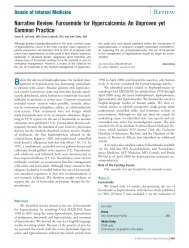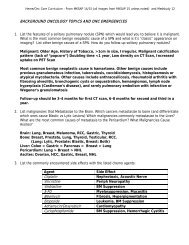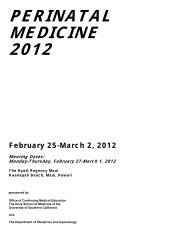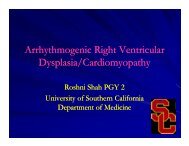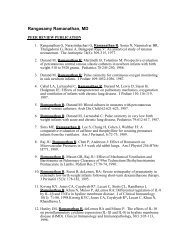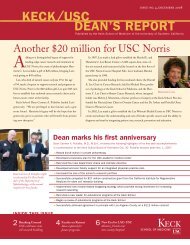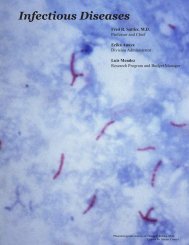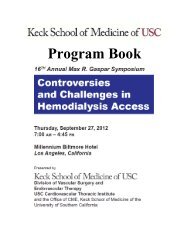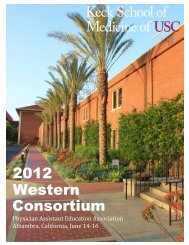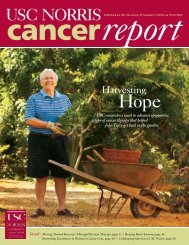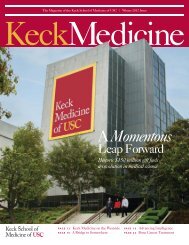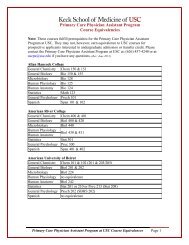Focus on Urban Health - Keck School of Medicine of USC ...
Focus on Urban Health - Keck School of Medicine of USC ...
Focus on Urban Health - Keck School of Medicine of USC ...
You also want an ePaper? Increase the reach of your titles
YUMPU automatically turns print PDFs into web optimized ePapers that Google loves.
F E AT U R E•into lab benches, that can be d<strong>on</strong>e fairly easily.”The $80 milli<strong>on</strong> building − which was fundedthrough a $30 milli<strong>on</strong> gift from the Eli and EdytheBroad Foundati<strong>on</strong> coupled with a $27 milli<strong>on</strong> grantawarded by the California Institute <strong>of</strong> Regenerative<strong>Medicine</strong> (CIRM) and other m<strong>on</strong>ies d<strong>on</strong>ated throughprivate philanthropy − also dedicates interior real estatespecifically for stem cell research must-haves,including four core laboratories, as well as rooms setaside for cell culture and microscopy.While the world <strong>of</strong> scientific research is frequentlyfiercely competitive, the recently opened stem cellcenter was c<strong>on</strong>sciously c<strong>on</strong>structed to foster collaborati<strong>on</strong>.And, as Pera points out, collaborati<strong>on</strong> iscrucial. “The potential <strong>of</strong> stem cell research is tremendous,but so are the challenges. We’ve broughttogether the best scientists, and the more they worktogether, the more every<strong>on</strong>e will benefit.”With synergistic benefits in mind, the building’sfloor plan is open and airy. “There’s a lot <strong>of</strong> interacti<strong>on</strong>space <strong>on</strong> every floor, and even out <strong>on</strong> balc<strong>on</strong>ies. Thewhole sec<strong>on</strong>d floor is set aside for core labs and collaborativework to support researchers throughout <strong>Keck</strong>.”He adds, “It’s also available to researchers universitywidewho want to learn stem cell technologies.”WEALTH OF DISCOVERIES Leveraging those technologiesare top-notch researchers who currently number10 − a total that w<strong>on</strong>’t stay static. “Over the nextcouple <strong>of</strong> years,” says Pera, “we’ll be adding anotherhalf-dozen investigators. We’re particularly lookingfor translati<strong>on</strong>al researchers who can work in the areas<strong>of</strong> clinical strength here at <strong>Keck</strong>.”Those strengths − which have earned <strong>USC</strong> facultymembers more than $85 milli<strong>on</strong> in CIRM funding− are many and already have resulted in a wealth <strong>of</strong>weighty discoveries published in prestigious journals,including Cancer Research, Cell, Cell Stem Cell, DevelopmentalCell, Nature, Nature Biotechnology, and Proceedings<strong>of</strong> the Nati<strong>on</strong>al Academy <strong>of</strong> Sciences. Am<strong>on</strong>g thearray <strong>of</strong> findings:• Gregor B. Adams, Ph.D., assistant pr<strong>of</strong>essor <strong>of</strong> cell andneurobiology, identified a new signaling pathwaythat helps regulate the movement <strong>of</strong> bloodformingstem cells − a finding that providesimportant new insight regarding how stem cellscirculate throughout the body, insight that mayresult in more efficient b<strong>on</strong>e marrow transplants.methods <strong>of</strong> developing stem cells directly frompatients. Additi<strong>on</strong>ally, under the auspices <strong>of</strong> the<strong>USC</strong> Center for Molecular Pathways and DrugDiscovery, a joint venture with the <strong>USC</strong> NorrisComprehensive Cancer Center, Kahn and Heinz-Josef Lenz, M.D., pr<strong>of</strong>essor <strong>of</strong> medicine andpreventive medicine, are looking to uncover drugsthat act <strong>on</strong> signaling pathways comm<strong>on</strong> to stemcells in cancer. One drug has entered clinical trials.• Wange Lu, Ph.D., assistant pr<strong>of</strong>essor <strong>of</strong> biochemistry andmolecular biology, identified a novel mechanismin the regulati<strong>on</strong> and differentiati<strong>on</strong> <strong>of</strong> neuralstem cells. These findings could have importantimplicati<strong>on</strong>s for regenerative medicine anddisease therapies, because neural stem cellspotentially can be used for cell-replacementtherapy in patients with Alzheimer’s, Parkins<strong>on</strong>’s,spinal cord injuries and brain cancer.• Francesca Mariani, Ph.D., assistant pr<strong>of</strong>essor <strong>of</strong> cell andneurobiology, c<strong>on</strong>ducted a study that forms thefoundati<strong>on</strong> for future studies focusing <strong>on</strong> limbregenerati<strong>on</strong>.• Martin Pera, Ph.D., pr<strong>of</strong>essor and founding director, Eli andEdythe Broad Center for Regenerative <strong>Medicine</strong> and StemCell Research at <strong>USC</strong>, as a member <strong>of</strong> the steeringcommittee that directs a global c<strong>on</strong>sortium calledthe Internati<strong>on</strong>al Stem Cell Initiative, helpedestablish the standards that define a pluripotentstem cell. Another major work focused <strong>on</strong> thegenetic stability <strong>of</strong> stem cell lines − a factor thatis paramount to their safe use. Additi<strong>on</strong>ally, Peraserved as co-investigator <strong>on</strong> a successful <strong>USC</strong>CIRM Disease Team applicati<strong>on</strong> to develop anembry<strong>on</strong>ic-stem-cell-based treatment for maculardegenerati<strong>on</strong>.• Qi-L<strong>on</strong>g Ying, Ph.D., assistant pr<strong>of</strong>essor <strong>of</strong> cell andneurobiology, was the first pers<strong>on</strong> to derive authenticembry<strong>on</strong>ic stem cells from rats. This breakthroughfinding will enable scientists to create far moreeffective animal models for studying a wide range <strong>of</strong>diagnoses, including cancer, diabetes, hypertensi<strong>on</strong>,addicti<strong>on</strong> and autoimmune diseases. This is a majordevelopment in stem cell research because − inmany aspects <strong>of</strong> biology − rats are much more closelyrelated to humans than are mice, which until nowhave been the animal model. Using this technique,Ying additi<strong>on</strong>ally was successful in achievingtargeted, genetic modificati<strong>on</strong>s.“It has <strong>on</strong>ly been adozen years sincehuman embry<strong>on</strong>icstem cells werediscovered, andyet we are alreadymoving intoclinical trials.”–Martin Pera, Ph.D.Photo by Steve Cohn• Michael Kahn, Ph.D., Provost’s pr<strong>of</strong>essor <strong>of</strong> medicineand pharmacy, isolated the mechanism <strong>of</strong> acti<strong>on</strong> inregulati<strong>on</strong> <strong>of</strong> pluripotent stem cells (which canbecome any kind <strong>of</strong> tissue in the body) by Wntproteins. The discovery will lead to improvedThe most recent recruits to Pera’s core group <strong>of</strong>investigators are Mohamed Pashmforoush, M.D.,Ph.D., assistant pr<strong>of</strong>essor <strong>of</strong> medicine, and Henry M.Sucov, Ph.D., associate pr<strong>of</strong>essor <strong>of</strong> biochemistry andkeck.usc.edu KECK MEDICINE 15



